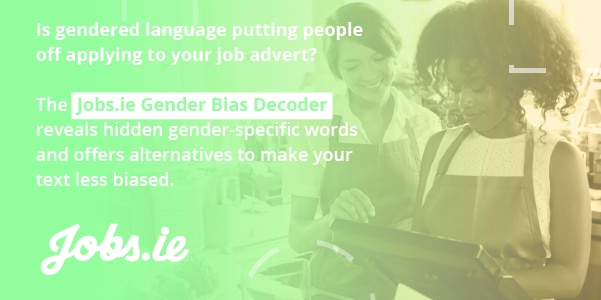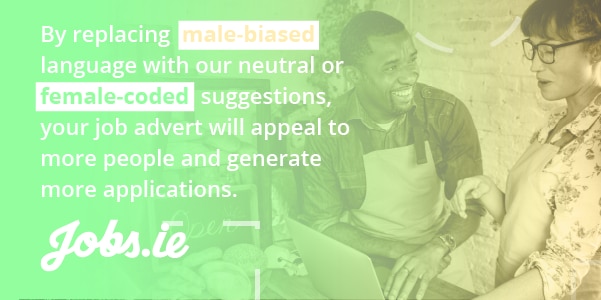Are you missing out on the best people for your business because of gendered language in your job adverts?
To support your hiring and to back your efforts to build an inclusive workplace, we have launched the Jobs.ie Gender Bias Decoder. This free tool reveals the unconscious gender-biased words in your job adverts and suggests alternatives, ensuring your jobs are open to the widest possible pool of talent.

Academic research from The University of Waterloo and Duke University* outlined a series of male and female gender-coded words which affects who applies.
Job adverts for roles in male-dominated industries tend to use more male-coded words. And on average, women find job adverts less appealing when they use male-biased language. Removing this bias can have a positive effect on the number of applications from female candidates.
The same isn’t true for female-coded words – they show no difference in applications across male- and female-dominated industries.

Male and female coded words are terms that reflect male and female stereotypes. For example, according to the research, “independent” is a word that tends to be associated with men, while “responsible” is usually associated with women.
Does this mean women can’t be assertive or dominant? Not at all. However, research shows women subconsciously feel those words relate less to them compared to other words. While women might find heavily male-coded job ads less attractive but it doesn’t mean women can’t have any of the male-coded traits.

Using the original study, Jobs.ie linguists and data experts have created a dictionary of male- and female-coded words. They’ve also made a list of synonyms for the male-coded words, which can be either neutral or female-coded.
The Jobs.ie Gender Bias Decoder highlights these gendered words to help identify unintentional gender bias in job adverts. The male-coded words can reduce your number of applicants, so we’ve provided alternative suggestions for these. We’ve decided not to show alternatives for female-coded words, as the research shows that they don’t have the same negative impact on job applicants.
The Gender Bias Decoder can be easily accessed when jobs are being prepared for posting, making it simple to check job descriptions for gendered language. By replacing male-biased language with our neutral or female-coded suggestions, your job advert will appeal to more people and generate more applications.


